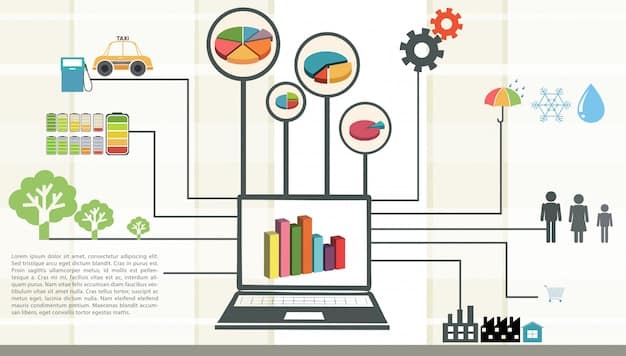Leverage Predictive Analytics to Forecast 2025 Marketing Campaigns

Predictive analytics is revolutionizing marketing by enabling data-driven forecasts of campaign performance, allowing businesses to optimize strategies, personalize customer experiences, and maximize ROI in the competitive landscape of 2025.
Ready to see the future of your marketing campaigns? In 2025, guessing is out and data-driven forecasting is in. Learn how to leverage predictive analytics to forecast marketing campaign performance in 2025 and stay ahead of the curve.
Understanding Predictive Analytics in Marketing
Predictive analytics is no longer a buzzword; it’s a vital tool for modern marketers. It uses statistical techniques, machine learning algorithms, and historical data to forecast future outcomes. Understanding how it integrates into marketing can transform your campaign strategies.
The Core Principles of Predictive Analytics
At its heart, predictive analytics relies on several core principles that enable it to generate accurate forecasts and insights. These principles revolve around data collection, model building, and continuous refinement.
- Data Collection and Preparation: Gathering comprehensive and relevant data is the first step. This involves extracting data from various sources, cleaning it, and transforming it into a format suitable for analysis.
- Model Building: Predictive models are constructed using machine learning algorithms. These models analyze historical data to identify patterns and relationships that can be used to predict future outcomes.
- Model Validation: Validating the model ensures its accuracy and reliability. This involves testing the model against new data and refining it based on the results.
- Deployment and Monitoring: Once validated, the model is deployed to provide real-time insights. Continuous monitoring is essential to ensure the model remains accurate and adapts to changing conditions.
Why Predictive Analytics Matters for 2025
Looking ahead to 2025, the importance of predictive analytics in marketing will only amplify. The sheer volume of data, increasing customer expectations, and intensifying competition necessitate smarter, more data-driven approaches.

Predictive analytics enables marketers to:
- Personalize Customer Experiences: By predicting customer behavior, marketers can tailor content, offers, and interactions to individual preferences, enhancing engagement and loyalty.
- Optimize Campaign Performance: Forecasts allow marketers to identify which strategies are likely to succeed, enabling them to allocate resources effectively and maximize ROI.
- Reduce Risk: Predictive models can flag potential issues before they escalate, allowing marketers to take proactive measures to mitigate risks and prevent costly mistakes.
In conclusion, understanding the principles and significance of predictive analytics is crucial for marketers aiming to thrive in 2025. By embracing these tools, businesses can gain a competitive edge and deliver more effective, personalized experiences to their customers.
Setting the Stage: Data Collection and Preparation
Data is the backbone of predictive analytics. Without high-quality data, even the most sophisticated algorithms are rendered useless. Proper data collection and preparation are essential to ensure accurate and reliable forecasts.
Identifying Key Data Sources
The first step in data collection is identifying the sources that hold valuable information about your customers and campaigns. These sources can be internal or external, depending on your specific needs and goals.
Common data sources include:
- CRM Systems: Customer Relationship Management (CRM) systems store valuable data about customer interactions, purchase history, and preferences.
- Website Analytics: Tools like Google Analytics provide insights into user behavior on your website, including traffic sources, engagement metrics, and conversion rates.
- Social Media Platforms: Social media platforms offer data about customer demographics, interests, and engagement with your brand.
- Marketing Automation Platforms: These platforms track customer interactions across various channels, providing a comprehensive view of the customer journey.
Ensuring Data Quality and Consistency
Once you’ve identified your data sources, it’s crucial to ensure the quality and consistency of the data. This involves cleaning the data to remove errors, inconsistencies, and duplicates.
Key steps include:
- Data Cleaning: Removing incorrect, incomplete, or irrelevant data points.
- Data Transformation: Converting data into a consistent format.
- Data Integration: Combining data from multiple sources into a unified dataset.
Utilizing APIs for Seamless Data Integration
Application Programming Interfaces (APIs) play a crucial role in seamlessly integrating data from diverse sources into a unified platform. APIs enable different systems to communicate and exchange data in real-time, streamlining the data collection process.
By leveraging APIs, marketers can:
- Automate Data Collection: Automatically pull data from various sources without manual intervention.
- Ensure Data Accuracy: Minimize errors by transferring data directly from the source system.
- Improve Data Availability: Access real-time data for more accurate and timely forecasts.

Effective data collection and preparation are foundational to leveraging predictive analytics. By focusing on identifying key data sources, ensuring data quality, and utilizing APIs for seamless integration, marketers can set the stage for accurate and impactful campaign forecasts.
Selecting the Right Predictive Models
Choosing the right predictive models is essential for generating accurate marketing forecasts. Different models are suited to various types of data and business objectives, so understanding the options is key.
Overview of Common Predictive Models
Several types of predictive models are commonly used in marketing, each with its strengths and weaknesses. Understanding these models can help you select the best fit for your specific needs.
Common models include:
- Regression Models: Predicting continuous values, such as customer lifetime value or sales revenue.
- Classification Models: Categorizing data into distinct classes, such as customer churn or lead scoring.
- Clustering Models: Grouping similar data points together, such as customer segmentation or product recommendations.
- Time Series Analysis: Forecasting future values based on historical trends, such as website traffic or social media engagement.
Matching Models to Marketing Objectives
The selection of a predictive model should align with your specific marketing objectives. Each model is designed to address different types of questions and provide unique insights. This alignment ensures that the insights derived are relevant and actionable.
For example:
- Objective: Predict customer churn. Model: Classification Model
- Objective: Forecast sales revenue. Model: Regression Model
- Objective: Identify customer segments. Model: Clustering Model
Evaluating Model Performance and Accuracy
Evaluating the performance and accuracy of your predictive models is essential for ensuring their reliability. This involves using various metrics and techniques to assess how well the model is performing and identifying areas for improvement.
Key metrics include:
- Accuracy: The percentage of correct predictions made by the model.
- Precision: The proportion of true positives out of all positive predictions.
- Recall: The proportion of true positives out of all actual positives.
- F1-Score: The harmonic mean of precision and recall, providing a balanced measure of accuracy.
By carefully selecting the right predictive models, aligning them with your marketing objectives, and continuously evaluating their performance, you can generate accurate forecasts that drive better business outcomes. This strategic approach to model selection ensures that your predictive analytics efforts deliver tangible value.
Implementing Machine Learning for Marketing Forecasts
Machine learning (ML) is a powerful subset of artificial intelligence that enables systems to learn from data and make predictions without explicit programming. Implementing machine learning can significantly enhance the accuracy and effectiveness of marketing forecasts.
Choosing the Right ML Algorithms
Selecting the appropriate machine learning algorithm is critical for achieving accurate and reliable marketing forecasts. Different algorithms excel in different scenarios, so understanding their strengths and weaknesses is essential.
Popular ML algorithms include:
- Linear Regression: Suitable for predicting continuous values with linear relationships.
- Logistic Regression: Used for binary classification problems, such as predicting customer churn.
- Decision Trees: Creating a tree-like model to make decisions based on data attributes.
- Random Forests: An ensemble of decision trees that improves accuracy and reduces overfitting.
- Neural Networks: Complex models inspired by the human brain, capable of learning intricate patterns in data.
Training and Testing Your ML Models
Training and testing are crucial steps in the machine learning process. Training involves feeding historical data into the model so it can learn patterns and relationships. Testing involves evaluating the model’s performance on new, unseen data to ensure its accuracy.
Key steps include:
- Data Splitting: Dividing the data into training and testing sets.
- Model Training: Feeding the training data to the ML algorithm to learn patterns.
- Model Evaluation: Assessing the model’s performance on the testing data using appropriate metrics.
- Hyperparameter Tuning: Adjusting the model’s parameters to optimize its performance.
Automating ML Processes with Marketing Tools
Automating machine learning processes can streamline your marketing forecasts and make them more efficient. Many marketing tools offer built-in ML capabilities that can automate tasks such as data collection, model training, and prediction generation.
Benefits of Automation:
- Increased Efficiency: Automate repetitive tasks, freeing up time for strategic activities.
- Improved Accuracy: Reduce human error and ensure consistent results.
- Real-Time Insights: Generate predictions in real-time for more timely decision-making.
By implementing machine learning techniques and automating ML processes, marketers can create more accurate and effective marketing forecasts. Selecting the right algorithms, training and testing your models, and leveraging marketing automation tools will enable you to stay ahead of the competition and make data-driven decisions.
Integrating Predictive Analytics into Marketing Channels
Integrating predictive analytics into various marketing channels can dramatically improve campaign performance. By leveraging predictive insights, marketers can personalize customer experiences, optimize channel strategies, and maximize ROI.
Personalizing Customer Journeys
Predictive analytics enables marketers to personalize customer journeys by delivering tailored content, offers, and interactions at each stage. By predicting customer preferences and behaviors, you can create more relevant and engaging experiences that drive conversions.
Strategies for Personalization:
- Personalized Email Marketing: Delivering customized email content based on customer behavior and preferences.
- Dynamic Website Content: Displaying personalized website content tailored to individual visitors.
- Product Recommendations: Recommending products based on past purchases and browsing history.
Optimizing Advertising Spend
Predictive analytics can help optimize advertising spend by identifying which channels and campaigns are most likely to generate positive results. By forecasting the performance of different advertising strategies, you can allocate your budget more effectively and reduce wasted spend.
Benefits of Optimized Advertising Spend:
- Improved ROI: Allocate budget to high-performing channels and campaigns.
- Reduced Waste: Avoid spending on ineffective advertising strategies.
- Better Targeting: Target the most receptive audiences with tailored messaging.
Enhancing Social Media Engagement
Predictive analytics can also enhance social media engagement by identifying the most impactful content, optimal posting times, and influential users. By forecasting social media trends and customer sentiment, you can create more engaging and effective social media campaigns.
Consider these Enhancements:
- Content Optimization: Create relevant content based on predicted customer preferences.
- Optimal Posting Times: Schedule posts for maximum visibility and engagement.
- Influencer Identification: Partner with influencers who resonate with your target audience.
Integrating predictive analytics into marketing channels is a game-changer for marketers. By personalizing customer journeys, optimizing advertising spend, and enhancing social media engagement, you can achieve better results and drive business growth. Embracing predictive insights will enable you to create more effective and data-driven marketing strategies.
Measuring and Iterating: Continuous Improvement
The journey with predictive analytics doesn’t end with implementation. Continuous measurement and iteration are crucial for refining your models and ensuring their ongoing accuracy. This ongoing process ensures that your marketing forecasts remain reliable and drive business value.
Establishing Key Performance Indicators (KPIs)
Establishing Key Performance Indicators (KPIs) is the first step in measuring the effectiveness of your predictive analytics initiatives. KPIs provide a clear and quantifiable way to track your progress and identify areas for improvement.
Common KPIs for Measuring Success:
- Prediction Accuracy: The percentage of correct predictions made by the models.
- ROI Improvement: The increase in return on investment resulting from predictive analytics.
- Customer Engagement: Metrics such as click-through rates, conversion rates, and social media engagement.
Analyzing Results and Identifying Improvements
Once you’ve established your KPIs, it’s essential to continuously analyze the results and identify areas for improvement. This involves reviewing your model’s performance, identifying patterns, and making adjustments to optimize its accuracy.
Use these strategies:
- Regular Model Audits: Review the model’s performance and identify areas for optimization.
- Data Quality Checks: Ensure the data remains accurate and consistent.
- Feedback Collection: Gather feedback from stakeholders on the effectiveness of the predictions.
Adapting to Changing Market Conditions
The marketing landscape is constantly evolving, so it’s crucial to adapt your predictive models to changing market conditions. This involves monitoring trends, updating your data, and retraining your models to reflect the latest developments.
Key Adaptation Strategies:
- Trend Monitoring: Stay informed about emerging market trends and customer behaviors.
- Data Updates: Regularly update your data with the latest information.
- Model Retraining: Retrain your models periodically to ensure they remain accurate.
| Key Point | Brief Description |
|---|---|
| 📊Understanding Predictive Analytics | Learn core principles and why predictive analytics is vital for marketing in 2025. |
| 🗂️Data Collection and Preparation | Identify key data sources and ensure data quality for accurate forecasts. |
| 🤖Implementing Machine Learning | Use ML algorithms to train predictive models and automate processes. |
| 📈Measuring and Iterating | Establish KPIs, analyze results, and adapt to changing market conditions. |
FAQ
Predictive analytics uses statistical techniques and machine learning to analyze historical data and forecast future marketing outcomes, enhancing decision-making.
High-quality data ensures that predictive models are accurate and reliable, preventing misleading results and enabling more effective marketing strategies.
Machine learning algorithms can automatically learn from data, identify complex patterns, and improve the accuracy of marketing forecasts over time.
Common models include regression, classification, clustering, and time series analysis, each suited for different types of marketing objectives and data.
Success is measured through KPIs such as prediction accuracy, ROI improvement, and enhanced customer engagement, ensuring continuous refinement and adaptation.
Conclusion
In 2025, leveraging predictive analytics will be crucial for forecasting marketing campaign performance and achieving optimal results. By focusing on data quality, selecting the right models, implementing machine learning, and continuously measuring and iterating, marketers can stay ahead of the competition and drive business growth.





